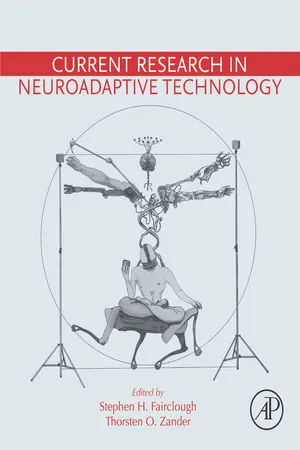
- 482 pages
- English
- ePUB (mobile friendly)
- Only available on web
Current Research in Neuroadaptive Technology
About This Book
Current Research in Neuroadaptive Technology provides readers with insight intothe state-of-the-artfield of neuroadaptive technology. The book covers the breadth and depth of current research in this field, covering a range of application domains in sufficient technical detail. The multidisciplinary character of this field means that the publication of key research is often fragmented across specialist journals. Here, the editors have consolidated current research, carefully selecting key topics that are clustered around the concept of neuroadaptive technology. In summary, the book meets the needs of readers by consolidating multidisciplinary research around a nascent technological concept.
The topic of neuroadaptive technology is novel and contemporary and editors Dr. Stephen H.Fairclough and Dr. Thorsten O. Zander have captured issues related to this emerging technology at the point of inception. It is a key reference for biomedical engineers and researchers in neural engineering, biomedical engineering, computer science, and mathematics.
- Includes applications of neuroadaptive technology in a variety of disciplines
- Comprises in-depth technical coverage of Passive Brain-Computer Interfaces, Physiological Computing, Affective Computing, Neurofeedback, and Closed-Loop Human-Computer Interaction
- Covers topics such as monitoring safety-critical behaviour, brain-computer interfaces, neurofeedback, virtual reality, neurostimulation, tangible interfaces, mobile brain-body imaging, system taxonomy and ethical implications of neuroadaptive technology
- Covers applied research using techniques such as: EEG, fNIRS, eye-tracking, psychophysiology, spontaneous radio frequency transmission and tDCS
- Written by engineers to help engineers, computer scientists, researchers and clinicians understand the technology and its applications
Frequently asked questions
Information
Table of contents
- Cover image
- Title page
- Table of Contents
- Copyright
- List of contributors
- Preface
- Chapter 1: Designing human-computer interaction with neuroadaptive technology
- Chapter 2: Defining neuroadaptive technology: the trouble with implicit human-computer interaction
- Chapter 3: The multi-stage theory of neurofeedback learning: a framework for understanding mechanisms
- Chapter 4: Towards neuroadaptive modeling: assessing the cognitive states of pilots through passive brain-computer interfacing
- Chapter 5: Tangible physiological devices for positive computing, a retrospective
- Chapter 6: The influence of a neuroadaptive game as a distraction from pain: a fNIRS study
- Chapter 7: Ecological measures of cognitive impairments in aeronautics: theory and application
- Chapter 8: Transcranial Direct-Current Stimulation (tDCS) attenuates perceived temporal demand during simulated laparoscopic tasks
- Chapter 9: Adaptive virtual reality
- Chapter 10: Possibilities and pitfalls for the co-registration of mobile EEG and eye-tracking in the study of economic decision-making in naturalistic settings
- Chapter 11: The impact of electrode shifts on BCI classifier accuracy
- Chapter 12: Walking improves the performance of a brain-computer interface for group decision making
- Chapter 13: Spontaneous radiofrequency emission from electron spins within Drosophila: a novel biological signal
- Abstracts from the First Neuroadaptive Technology Conference, 2017
- Abstracts from the Second Neuroadaptive Technology Conference, 2019
- Index